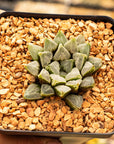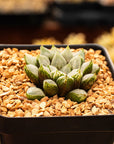


Haworthia magnifica 'Love Life'
In a nod to its name, this cultivar forms a star-like rosette of distinctly heart-shaped leaves with finely textured surfaces. The main feature is the translucent 'window' at the end of each leaf, which is often marked with fine longitudinal lines, and the plant maintains a dark green color.
In its native habitat in the Western Cape of South Africa, the parent species Haworthia magnifica grows almost completely buried in the soil, with only these windowed tips exposed. This clever adaptation allows sunlight to reach the plant for photosynthesis while keeping it protected. While the species typically forms clumps, the 'Love Life' cultivar tends to remain solitary.
Light Level
Water
Shipping Notes
Haworthias are a group of small succulents native to South Africa, where they grow in rocky, shaded areas and often tuck themselves into crevices or under shrubs. Most form low, compact rosettes and grow slowly, making them well suited to pots and small spaces.
Leaf shape and texture vary across the genus—from firm and spiky to soft and translucent. Many species have “windows” at the tips of their leaves—clear or translucent areas that let light into the interior of the leaf. This adaptation helps them photosynthesize while staying partly buried or shaded in their native habitat.
Some haworthias stay solitary, while others offset freely and form clumps over time. They do best in bright, indirect light and need a well-draining soil mix. Water thoroughly when dry, and go lighter in winter. Their natural ability to handle low water and filtered light makes them easy to grow indoors, especially on windowsills or under lights.
Because of their variation in form and texture, they’re a favorite among collectors—especially for growers who like compact plants with subtle detail.



